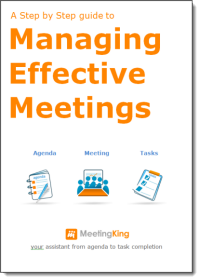
Meetings can be incredibly valuable for collaboration, and decision-making, but they can also be a major drain on resources if not managed efficiently. That’s why meeting cost reduction is so important.
In fact, according to a study by Harvard Business Review, executives spend an average of 23 hours per week in meetings. By implementing effective meeting cost reduction strategies, organizations can not only save time and money but also improve overall efficiency.
So, how can you reduce meeting costs without sacrificing productivity and effectiveness? Let’s have a look at the key benefits of doing this and eight practical strategies and best practices you can implement.
The Importance and Benefits of Meeting Cost Reduction
Before we dive into the strategies, it is worth highlighting why reducing meeting costs is important.
For starters, it can save your organization money, which can be used to invest in other areas. In addition, improved meeting efficiency can also lead to more engaged employees who contribute to the discussion. As a result, facilitating better decision-making and increased innovation.
Finally, by reducing the amount of time spent in meetings, employees have more time to focus on their work, which can lead to increased productivity and better performance.
11 Strategies for Meeting Cost Reduction
1. Invite the Right People
One essential strategy for meeting cost reduction is to invite the right people. When inviting attendees, consider their expertise, relevance to the topics being addressed, and their ability to provide valuable insights or make informed decisions.
Ultimately, having the right people can provide several benefits. It helps streamline the meeting process, allows for more focused conversations, and promotes better decision-making and problem-solving.
2. Meet Online
In today’s digital age, you can leverage online meeting platforms and conduct meetings virtually. This offers numerous advantages, including increased flexibility, reduced travel costs, and improved scheduling options. Virtual meetings allow participants to connect from different locations, eliminating the need for travel expenses and saving valuable time.
By integrating online meetings into your strategy, you can achieve significant cost savings while maintaining effective communication and collaboration.
3. Collaborate on Meeting Agendas
To ensure that meetings are focused and productive, it’s essential to have a clear agenda. By collaborating on the agenda with all attendees beforehand, everyone will be clear on what the meeting will cover and be prepared to contribute to the discussion. As a result, reducing the amount of time spent on irrelevant topics.
For example, let’s say that you’re scheduling a meeting to discuss a new product launch. By collaborating on the agenda with all participants beforehand, you can ensure that the meeting will focus on the most important aspects of the launch, rather than getting sidetracked by less important details.
4. Prepare and Be Punctual
To ensure that meetings start and end on time, all participants should arrive on time and be prepared for the discussion. This means doing any necessary research or preparation beforehand and arriving at the meeting with a clear understanding of the agenda and goals.
Being punctual and prepared shows respect for other attendees’ time and ensures that the meeting runs smoothly.
5. Facilitate Contribution
To ensure that all participants are engaged and contributing to the discussion, create a supportive and inclusive meeting environment. You can achieve this by encouraging participation from all attendees, actively listening to their input, and providing opportunities for feedback and discussion. Subsequently, the best ideas and solutions are more likely to be brought to the table.
For example, you are leading a brainstorming session to come up with new product ideas. If you create an open environment where everyone feels comfortable sharing their thoughts, you will yield better results.
6. Stay on Task
If you want your meetings to be more focused and efficient, minimize distractions and keep the discussion on track. This means avoiding off-topic discussions, limiting side conversations and the use of mobile phones, as well as redirecting the discussion when necessary.
How can you minimize distractions? For instance, ask attendees to put their phones on silent mode. Or if you are using MeetingKing, you can the Parking Lot feature to move off-topic discussions to another meeting.
7. Define Clear Goals
Set clear goals for the meeting, so that everyone knows what is expected of them. This helps to ensure that everyone is working towards the same objectives and that the meeting stays on track.
Let’s say you’re scheduling a meeting to discuss the progress of a project. By setting specific goals for the meeting, such as identifying any roadblocks or areas where additional resources are needed, you can avoid misunderstanding and delays.
8. Use Meeting Tools
Using the right meeting tools and technology, such as MeetingKing, can improve communication and collaboration making your meetings more efficient. As a result, you will save time and resources and streamline communication and improve collaboration at the same time.
For example, MeetingKing is a great tool for managing meetings, allowing you to create and share agendas, write meeting minutes, assign and track action items, and send follow-up emails all in one place.
9. Ensure Closure
To enhance meeting outcomes it is crucial to ensure clear closure of each topic and facilitate seamless transitions. As discussions come to an end, the chairman should provide a concise summary of the key points, ensuring everyone understands the outcomes and decisions reached as well as actions that need to be taken.
Explicitly stating decisions made during the discussion establishes accountability and provides a reference for future follow-up. This practice fosters clarity and alignment among participants, ultimately driving productive results.
10. Delegate Tasks
Assigning action items is a crucial part of any meeting. By designating tasks to specific team members, you can ensure that everyone knows what they need to do and is accountable for their contributions. This can also help prevent confusion and errors down the line.
When delegating tasks, be sure to clearly communicate the scope and deadline for each item. Additionally, consider the skills and strengths of each team member so that everyone is working on something they are capable of completing.
11. Follow up After Meetings
One of the most important steps in meeting cost reduction is following up after the meeting is over. This involves sending a summary of the meeting, including action items, deadlines, and next steps to all attendees.
A follow-up email is a great way to make sure that everyone is on the same page and knows what is expected of them moving forward. You can easily automate this process and keep track of action items by using a meeting management tool like MeetingKing.
In Summary
By implementing these strategies and best practices, you can reduce meeting costs while still achieving your goals and objectives.
Remember, meetings don’t have to be a drain on resources – with a little planning and effort, they can be an effective and efficient way to collaborate and communicate in your business or organization.
__
The image above by Drazen Zigic on Freepik


